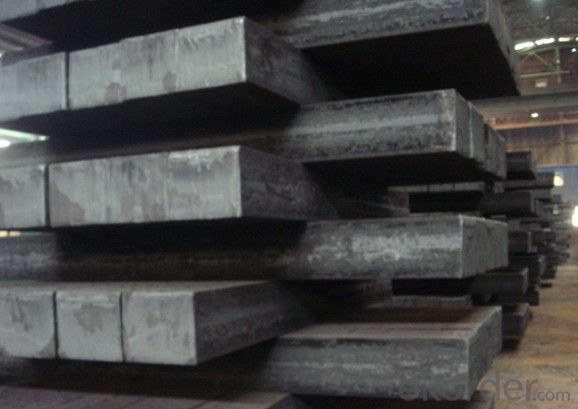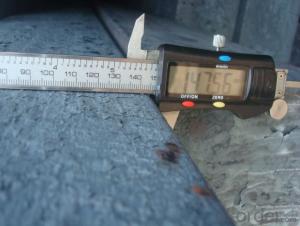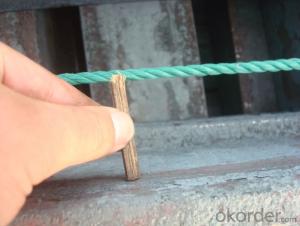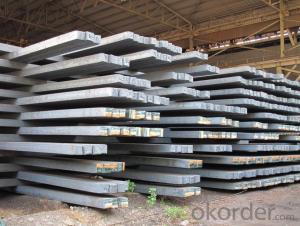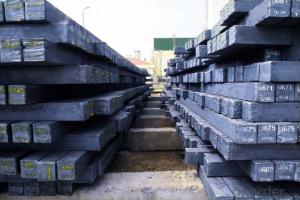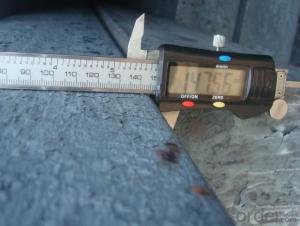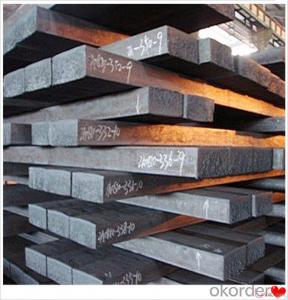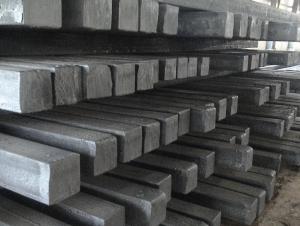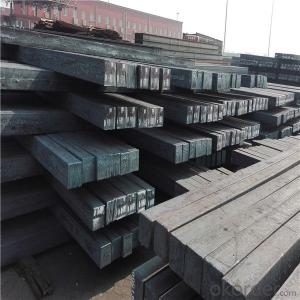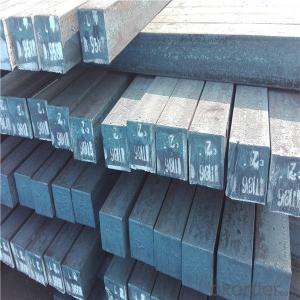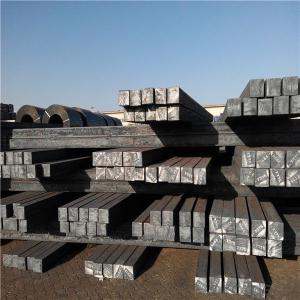Prime Hot Rolled Square Steel Billet for sale
- Loading Port:
- China main port
- Payment Terms:
- TT or LC
- Min Order Qty:
- 1000 m.t.
- Supply Capability:
- 10000 m.t./month
OKorder Service Pledge
OKorder Financial Service
You Might Also Like
Product Description:
OKorder is offering Prime Hot Rolled Square Steel Billet for sale at great prices with worldwide shipping. Our supplier is a world-class manufacturer of steel, with our products utilized the world over. OKorder annually supplies products to African, South American and Asian markets. We provide quotations within 24 hours of receiving an inquiry and guarantee competitive prices.
Product Applications:
Prime Hot Rolled Square Steel Billet for sale ideal for structural applications and are widely used in the construction of buildings and bridges, and the manufacturing, petrochemical, and transportation industries.
Product Advantages:
OKorder's Prime Hot Rolled Square Steel Billet for sale are durable, strong, and wide variety of sizes.
Main Product Features:
· Premium quality
· Prompt delivery & seaworthy packing (30 days after receiving deposit)
· Can be recycled and reused
· Mill test certification
· Professional Service
· Competitive pricing
Product Specifications:
Manufacture: Hot rolled
Grade: Q195/Q235/Q275/20MnSi
Certificates: ISO, SGS, BV
size:60*60/90*90/100*100/120*120/150*150
Length: 6m/12m,
Packaging: Export packing, nude packing, bundled
Standard | C(%) | Mn(%) | S(%) | P(%) | Si(%) |
20MnSi | 0.17-0.25 | 1.2-1.6 | ≤ 0.050 | ≤ 0.050 | 0.40-0.80 |
FAQ:
Q1: Why buy Materials & Equipment from OKorder.com?
A1: All products offered byOKorder.com are carefully selected from China's most reliable manufacturing enterprises. Through its ISO certifications, OKorder.com adheres to the highest standards and a commitment to supply chain safety and customer satisfaction.
Q2: How do we guarantee the quality of our products?
A2: We have established an advanced quality management system which conducts strict quality tests at every step, from raw materials to the final product. At the same time, we provide extensive follow-up service assurances as required.
Q3: How soon can we receive the product after purchase?
A3: Within three days of placing an order, we will arrange production. The normal sizes with the normal grade can be produced within one month. The specific shipping date is dependent upon international and government factors, the delivery to international main port about 45-60days.
Images:
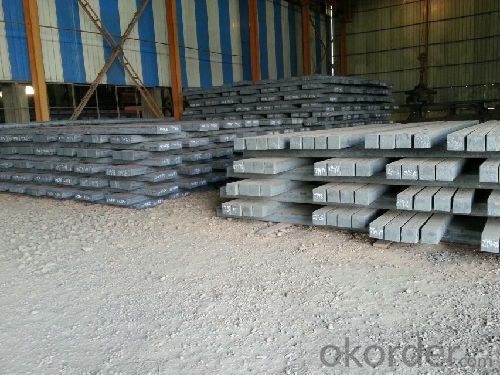
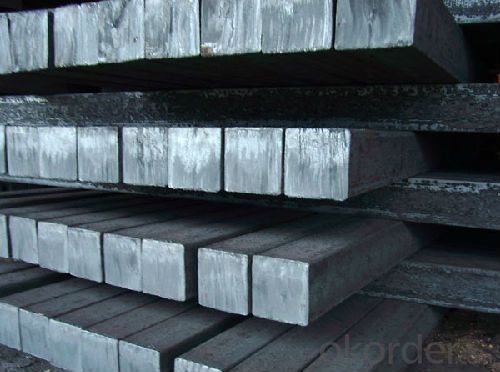
- Q:How are steel billets used in the manufacturing of fasteners?
- Steel billets are an essential component in the manufacturing of fasteners. Fasteners are devices used to join or secure two or more objects together. They are commonly found in various industries such as automotive, construction, and manufacturing. In the production of fasteners, steel billets serve as the raw material. A steel billet is a semi-finished product that typically has a square or rectangle cross-section. It is created through a process called casting, where molten steel is poured into a mold and allowed to cool and solidify. Once the steel billets are obtained, they undergo a series of manufacturing processes to transform them into fasteners. These processes include hot rolling, cold drawing, and machining. Hot rolling is the initial step, where the steel billets are heated to high temperatures and passed through a set of rollers. This process helps shape the billets into long, cylindrical bars or rods of the desired diameter. Next, the hot-rolled bars are subjected to a process called cold drawing. In this process, the bars are pulled through a series of dies to reduce their diameter and improve their surface finish. Cold drawing also helps enhance the mechanical properties of the steel, making it stronger and more durable. Finally, the steel bars are machined to create the specific fastener design. This involves cutting, threading, and forming the bars to produce bolts, screws, nuts, or other types of fasteners. The machined fasteners are then subjected to heat treatment processes such as quenching and tempering to further enhance their strength and hardness. In summary, steel billets are crucial in the manufacturing of fasteners as they provide the raw material that undergoes various transformation processes. Through hot rolling, cold drawing, and machining, steel billets are shaped into the desired form, resulting in high-quality fasteners that meet industry standards.
- Q:What are the different surface treatments available for steel billets?
- There are several surface treatments available for steel billets, including shot blasting, pickling, phosphating, and galvanizing. Shot blasting involves propelling abrasive materials at high speeds to remove rust and scale from the surface. Pickling involves immersing the billets in an acid solution to remove oxide layers and impurities. Phosphating applies a layer of phosphate coating to enhance corrosion resistance and improve paint adhesion. Galvanizing involves applying a zinc coating to protect the surface from corrosion.
- Q:How are steel billets used in the production of industrial boilers?
- Steel billets are used in the production of industrial boilers as they serve as the primary raw material for manufacturing boiler components such as tubes, pipes, and plates. These billets are heated, forged, and shaped into various boiler parts, ensuring the strength, durability, and reliability required for efficient boiler operation in industrial settings.
- Q:What are the different types of steel billet manipulation equipment?
- In the steel industry, there exists a variety of steel billet manipulation equipment. These machines serve the purpose of handling and manipulating semi-finished steel billets, which later undergo further processing to acquire different shapes and forms. The types of steel billet manipulation equipment are as follows: 1. Billet grabbers: Equipped with either hydraulic or mechanical arms, these machines possess the ability to securely grip and lift steel billets. They are commonly utilized for the loading and unloading of billets from storage areas, trucks, or trains. 2. Billet pushers: These machines find their utility in pushing steel billets along a conveyor system or into a furnace for additional processing. They are generally equipped with hydraulic systems that provide the necessary force to move the billets. 3. Billet transfer cars: Specialized vehicles, known as billet transfer cars, are employed for transporting steel billets within a steel plant. These vehicles feature a flat surface on which billets can be placed and moved from one location to another. 4. Billet cutting machines: These machines are dedicated to cutting steel billets into smaller pieces or removing excess material. They come in various configurations, such as circular saws, shearing machines, or abrasive cutting machines, and can be operated either manually or automatically. 5. Billet heating equipment: This category encompasses induction heating systems or furnaces used to heat steel billets to a specific temperature for further processing. These machines are indispensable in numerous heat treatment processes, including annealing or quenching. 6. Billet straightening machines: These machines are responsible for rectifying any deformations or bends that may occur during the billet manufacturing process. By applying controlled pressure and tension, they ensure that the billets are perfectly straight before proceeding to further processing. 7. Billet inspection equipment: These machines serve the purpose of inspecting the quality and dimensions of steel billets. They employ various techniques, such as ultrasonic testing, magnetic particle testing, or visual inspection, to identify any defects or flaws in the billets. Each type of steel billet manipulation equipment plays a vital role in the steel manufacturing process, guaranteeing the efficient handling, processing, and quality control of steel billets before they undergo transformation into finished products.
- Q:What are the different types of steel billet welding processes?
- There are several different types of steel billet welding processes that are commonly used in various industries. These processes include: 1. Shielded Metal Arc Welding (SMAW): Also known as stick welding, SMAW involves a flux-coated electrode that is manually fed into the welding pool. It is a versatile and widely used process for welding steel billets. 2. Gas Metal Arc Welding (GMAW): This process, commonly known as MIG welding, uses a continuously fed wire electrode and a shielding gas to protect the weld pool. It is a popular method for welding steel billets due to its efficiency and ease of use. 3. Flux-Cored Arc Welding (FCAW): FCAW is similar to GMAW, but it uses a tubular electrode filled with flux instead of a solid wire. This process is often preferred for outdoor or windy conditions as the flux provides better protection against atmospheric contamination. 4. Submerged Arc Welding (SAW): SAW involves feeding a consumable electrode and a granular flux into the weld zone, while the arc remains submerged beneath a layer of flux. It is commonly used for welding large steel billets due to its high deposition rates and deep penetration capabilities. 5. Gas Tungsten Arc Welding (GTAW): Also known as TIG welding, GTAW uses a non-consumable tungsten electrode and a shielding gas to protect the weld pool. It is a precise and high-quality welding process suitable for thin steel billets or applications that require exceptional weld aesthetics. 6. Electroslag Welding (ESW): ESW is a highly efficient process used for welding thick steel billets. It involves melting a consumable electrode and the base metal in a molten slag pool, which provides protection and acts as a filler material. 7. Laser Beam Welding (LBW): LBW utilizes a high-energy laser beam to melt and join steel billets together. It is a precise and fast welding process commonly used in industries such as automotive and aerospace. Each of these welding processes has its own advantages and limitations, and the choice of process depends on factors such as the type and thickness of the steel billet, desired weld quality, production requirements, and cost considerations.
- Q:How are steel billets used in the production of power generation equipment?
- Steel billets are used in the production of power generation equipment as they serve as the raw material for various components such as turbine blades, rotors, shafts, and casings. These billets are heated, forged, and machined to create the necessary shapes and sizes required for the efficient and reliable functioning of power generation equipment. The high strength and durability of steel make it an ideal choice for withstanding the extreme conditions and stresses involved in power generation processes.
- Q:What are the main factors affecting the formability of stainless steel billets?
- The formability of stainless steel billets is influenced by several key factors. These factors include the steel's composition, the forming temperature, the grain size and structure of the material, and the level of deformation applied during the forming process. To begin with, the composition of the stainless steel billet is a critical factor in determining its formability. The steel's composition, including the presence of alloying elements like chromium, nickel, and molybdenum, impacts its mechanical properties. For instance, higher levels of chromium can enhance corrosion resistance but may reduce formability. Therefore, selecting the appropriate stainless steel grade is essential to ensure optimal formability for a specific application. Furthermore, the temperature at which the stainless steel billet is formed is influential. Elevated temperatures increase the steel's ductility and, consequently, its formability. Heating the billet lowers its yield strength and facilitates easier deformation. However, excessive heating can result in grain growth and diminished mechanical properties. Thus, finding the right balance between temperature and formability is crucial. The grain size and structure of the stainless steel billet also affect its formability. In general, materials with finer grains exhibit better formability compared to those with coarser grains. Finer grains allow for more uniform deformation and reduce the likelihood of cracking or tearing during forming processes. Additionally, the presence of microstructural features like precipitates or twins can also impact the formability of stainless steel billets. Lastly, the amount of deformation applied during the forming process has a significant effect on the formability of the stainless steel billet. Excessive deformation can lead to strain hardening, making the material less ductile and more prone to cracking. Thus, careful control of the amount and distribution of deformation is necessary to achieve optimal formability. In summary, the formability of stainless steel billets is influenced by the composition of the steel, the forming temperature, the grain size and structure of the material, and the level of deformation applied during the forming process. Understanding and managing these factors are essential for achieving the desired formability and ensuring successful manufacturing of stainless steel components.
- Q:How are steel billets used in the production of shafts?
- Shafts require steel billets as an indispensable component for their production. These billets are semi-finished products that serve as the initial stage for diverse manufacturing processes. In the case of shaft production, steel billets serve as the raw material from which the shafts are formed. The process commences by heating the steel billets to a specific temperature, typically within a furnace. This heating procedure, referred to as "hot working," is of utmost importance as it renders the steel more pliable and easier to mold. Once the billet attains the desired temperature, it is subsequently transferred to either a forging press or a rolling mill. During the forging process, the heated billet undergoes high pressure and is shaped using specialized dies to achieve the desired dimensions for the shaft. This method permits precise control over the shape, size, and surface finish of the shaft. On the contrary, the rolling process entails the billet passing through a sequence of rollers that gradually shape it into a cylindrical form. Rolling is frequently employed for shafts necessitating a consistent cross-section along their length. Following the initial shaping process, the shafts go through additional steps such as heat treatment, machining, and finishing to fulfill the specific requirements of their intended applications. Heat treatment assists in enhancing the mechanical properties of the shaft, rendering it stronger, more durable, and resistant to wear. Subsequently, machining processes such as turning, milling, or grinding are conducted to achieve precise dimensions, smooth surfaces, and accurate tolerances. Altogether, steel billets occupy a pivotal role in the production of shafts as they serve as the starting point for the shaping processes imperative in creating these crucial components. Through meticulous manipulation and refinement, steel billets metamorphose into high-quality shafts utilized in a myriad of industries, including automotive, aerospace, manufacturing, and numerous others.
- Q:How do steel billets contribute to the overall aesthetics of a product?
- Steel billets do not directly contribute to the overall aesthetics of a product as they are semi-finished products in the steel manufacturing process. However, they play a crucial role in determining the structural integrity and quality of the final product, which indirectly impacts its overall aesthetics.
- Q:What are the main applications of steel billets in the aerospace industry?
- Steel billets possess exceptional strength, durability, and thermal properties, making them an indispensable component in the aerospace industry. Their numerous applications include the production of aircraft structural components, engine parts, fasteners and connectors, as well as hydraulic and pneumatic systems. A primary application of steel billets in the aerospace industry is seen in the manufacturing of aircraft structural components. These billets are commonly utilized to produce critical parts such as landing gear, wing spars, fuselage frames, and engine mounts. These components provide the necessary strength and stability required for safe and efficient flight. Furthermore, steel billets find use in the aerospace industry for the production of engine components. Their high heat resistance and ability to withstand extreme temperatures make them ideal for manufacturing turbine blades, shafts, and other critical parts within jet engines. These components must endure intense heat and pressure, and steel billets offer the required properties for reliable and efficient engine performance. Additionally, steel billets play a vital role in the aerospace industry by being applied in the production of fasteners and connectors. These components are crucial for securely joining various parts of an aircraft, ensuring structural integrity and safety during flight. Steel billets are employed to manufacture high-strength bolts, screws, and other fasteners, providing the necessary strength and reliability for aerospace applications. Moreover, steel billets are frequently used in the aerospace industry for the manufacture of hydraulic and pneumatic systems. These systems are responsible for controlling the movement of the aircraft, landing gear operation, and other critical functions. Steel billets are utilized to produce hydraulic cylinders, valves, and tubes, offering the required strength and resistance to withstand high pressures and extreme conditions. In conclusion, the aerospace industry heavily relies on steel billets for various applications, including aircraft structural components, engine parts, fasteners and connectors, as well as hydraulic and pneumatic systems. The exceptional strength, durability, and thermal properties of steel billets ensure the safety, efficiency, and reliability of aerospace operations.
1. Manufacturer Overview |
|
|---|---|
| Location | |
| Year Established | |
| Annual Output Value | |
| Main Markets | |
| Company Certifications | |
2. Manufacturer Certificates |
|
|---|---|
| a) Certification Name | |
| Range | |
| Reference | |
| Validity Period | |
3. Manufacturer Capability |
|
|---|---|
| a)Trade Capacity | |
| Nearest Port | |
| Export Percentage | |
| No.of Employees in Trade Department | |
| Language Spoken: | |
| b)Factory Information | |
| Factory Size: | |
| No. of Production Lines | |
| Contract Manufacturing | |
| Product Price Range | |
Send your message to us
Prime Hot Rolled Square Steel Billet for sale
- Loading Port:
- China main port
- Payment Terms:
- TT or LC
- Min Order Qty:
- 1000 m.t.
- Supply Capability:
- 10000 m.t./month
OKorder Service Pledge
OKorder Financial Service
Similar products
Hot products
Hot Searches
Related keywords



